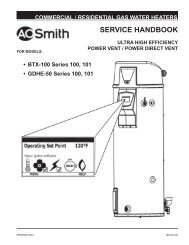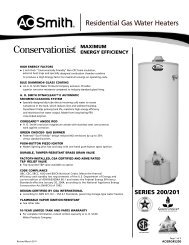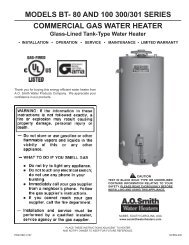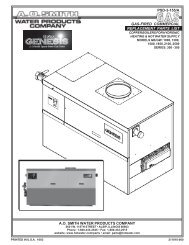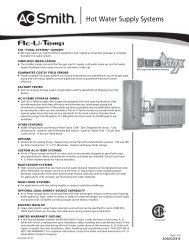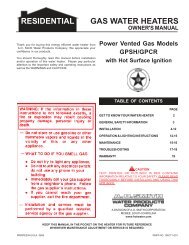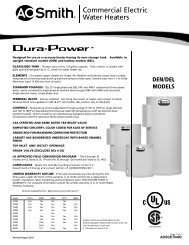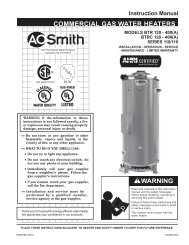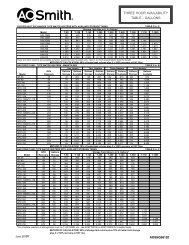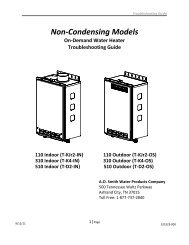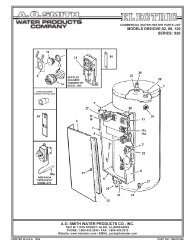320386-001 - AO Smith Water Heaters
320386-001 - AO Smith Water Heaters
320386-001 - AO Smith Water Heaters
You also want an ePaper? Increase the reach of your titles
YUMPU automatically turns print PDFs into web optimized ePapers that Google loves.
GAS SUPPLYWARNINGManual GasShut-off Valve• Use a new CSA approved gas supply line.• Install a shut-off valve.• Do not connect a natural gas water heater to an L.P. gassupply.• Do not connect an L.P. gas water heater to a natural gassupply.• Failure to follow these instructions can result in death,explosion, or carbon monoxide poisoning.Gas RequirementsExplosion HazardCheck with localutility forminimum heightGroundJointUnionGas Pressure3” MinimumDrip LegFIGURE 3.WARNING6” MaximumAir GapIMPORTANT: Read the rating plate to be sure the waterheater is made for the type of gas you will be using inyour home. This information will be found on the ratingplate located near the gas control valve/thermostat. If theinformation does not agree with the type of gas available,do not install or light. Call your dealer.NOTE: An odorant is added by the gas supplier to the gasused by this water heater. This odorant may fade over anextended period of time. Do not depend upon this odorantas an indication of leaking gas.Gas PipingThe gas piping must be installed according to all local andstate codes or, in the absence of local and state codes, the“National Fuel Gas Code”, ANSI Z223.1(NFPA 54)-currentedition.Tables 1 and 2 on the following page provide a sizingreference for commonly used gas pipe materials. Consultthe “National Fuel Gas Code” for the recommended gaspipe size of other materials.NOTE: Use pipe joint compound or teflon tape marked asbeing resistant to the action of petroleum [Propane (L.P.)]gases (See Figure 3.)1. Install a readily accessible manual shut-off valve in thegas supply line as recommended by the local utility.Know the location of this valve and how to turn off thegas to this unit.2. Install a drip leg (if not already incorporated as part ofthe water heater) as shown. The drip leg must be noless than three inches long for the accumulation of dirt,foreign material, and water droplets.3. Install a ground joint union between the gas controlvalve/thermostat and the manual shut-off valve. Thisis to allow easy removal of the gas control valve/thermostat.4. Turn the gas supply on and check for leaks. Test allconnections by brushing on an approved noncorrosiveleak-detection solution. Bubbles will show a leak.Correct any leak found.9Explosion Hazard• Gas leaks can not always be detected by smell.• Gas suppliers recommend that you use a gasdetector approved by UL or CSA.• For more information, contact your gas supplier.• If a gas leak is detected, follow the “What to do if yousmell gas” instructions on the cover of this manual.IMPORTANT: The gas supply pressure must not exceed themaximum supply pressure as stated on the water heater’s ratingplate. The minimum supply pressure is for the purpose of inputadjustment.Gas Pressure TestingIMPORTANT: This water heater and its gas connection mustbe leak tested before placing the appliance in operation.• If the code requires the gas lines to be tested at apressure exceeding 14” W.C., the water heater and itsmanual shut-off valve must be disconnected from the gassupply piping system and the line capped.• If the gas lines are to be tested at a pressure less than14” W.C., the water heater must be isolated from the gassupply piping system by closing its manual shut-off valve.NOTE: Air may be present in the gas lines and could preventthe pilot from lighting on initial start-up. The gas lines shouldbe purged of air by a qualified technician after installation ofthe gas piping system. While purging the gas piping systemof air, insure that the fuel is not spilled in the area of thewater heater installation, or any source of ignition. If thefuel is spilled while purging the piping system of air followthe “WHAT TO DO IF YOU SMELL GAS” instructions onthe cover of this manual.



